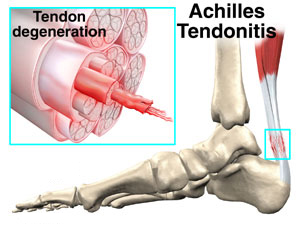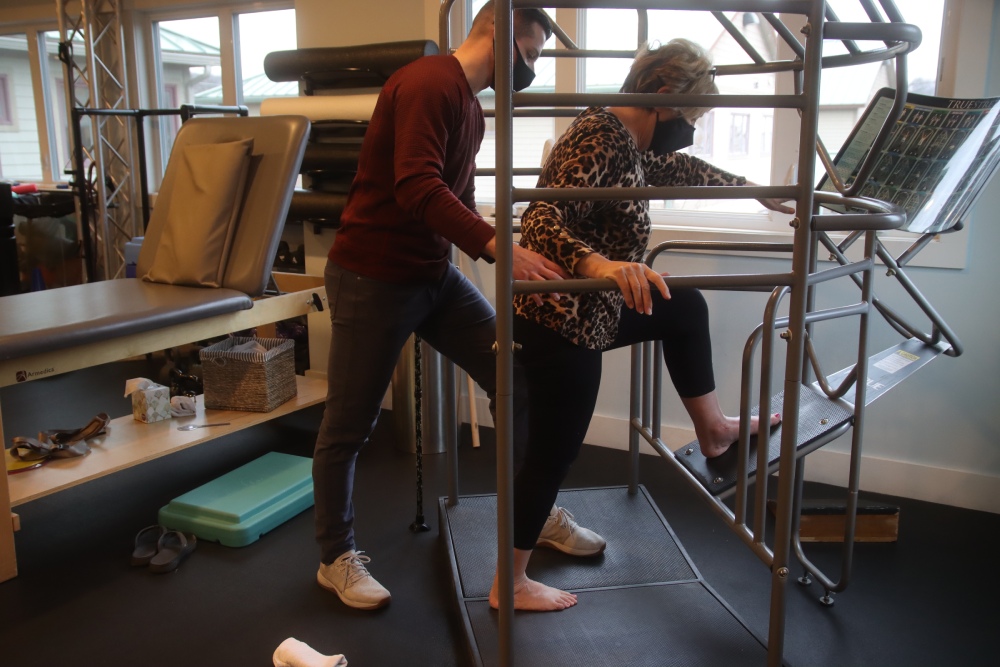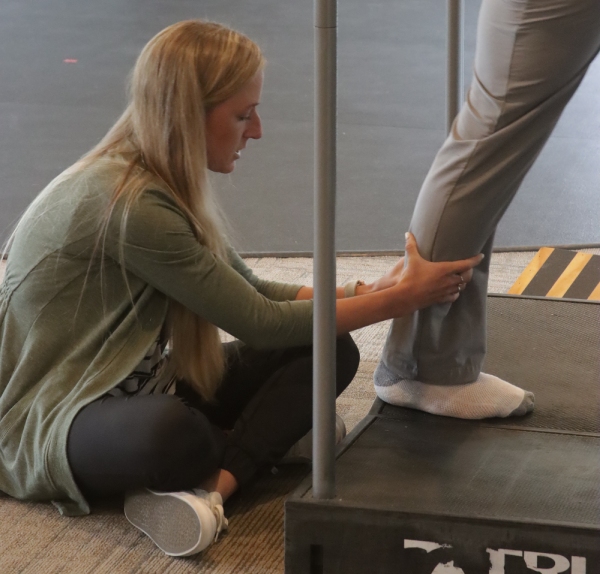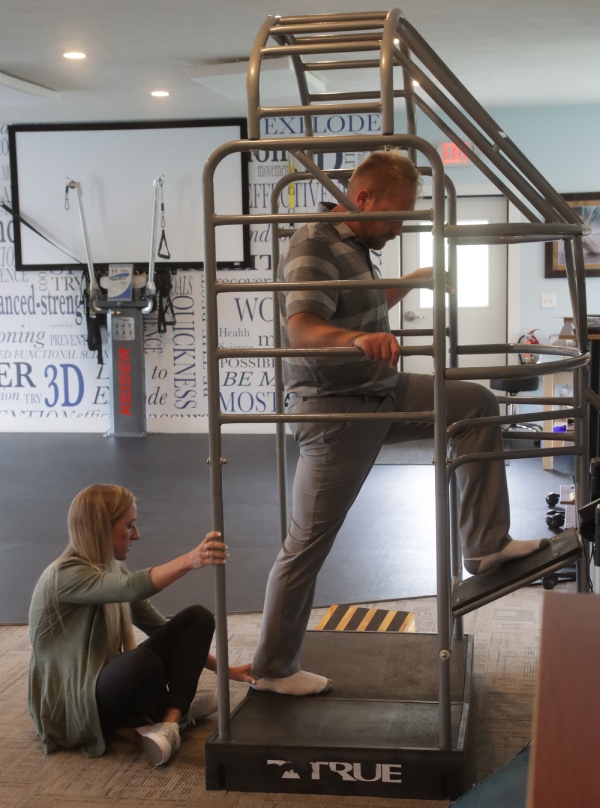- Traverse City, MI |
-
West: W Front St:
(231) 944-6541
-
| Central: Munson Ave :
(231) 421-9300


Achilles tendonitis is the irritation or inflammation of the Achilles tendon. It is the body’s natural response to injury or disease and often manifests as swelling, irritation, or pain.
The Achilles tendon is the largest tendon in the body, running down the lower back of the leg and bridging the calf muscles and the heel bone. It is used for climbing, running, walking, jumping, and standing on one’s toes.
Even if the Achilles tendon is able to withstand the stress of an array of activities, it can still suffer from overuse and degeneration.
A patient may need Achilles tendonitis therapy or treatment for this condition.

The problem lies in the fibers in the middle part of the tendon. These fibers have begun to degenerate and show tiny tears, often also swelling and thickening. Noninsertional Achilles Tendonitis usually affects younger and more active people.

On the other hand, insertional Achilles tendonitis affects the lower part of the tendon, where it connects or inserts to the heel bone. Extra bone growth or bone spurs usually occur. This type of tendonitis can also happen any time, to any type of patient, including inactive people.
However, more often than not, insertional Achilles tendonitis tends to affect runners or other types of people that may have exhibited years of overuse for the tendon.
There are some factors that make Achilles tendonitis more likely to occur.
Having bone spur or extra bone growth. This usually occurs in the area where the tendon meets the heel bone. This extra bone can rub against the tendon and cause pain and irritation.
Suddenly increasing the intensity or the amount of work done by the tendon. This usually occurs when a person switches to a more intensive workout routine without giving the body time to adjust.
The following are a few of the most common symptoms of Achilles tendonitis:
Stiffness accompanied by pain along the Achilles tendon which usually gets worse in the morning
Pain in the back of the heel or along the tendon which usually gets worse with stress or activity
Thickening of parts of the tendon
Extra bone growth or bone spur
Swelling that does not subside and progressively worsens throughout the day
People who have experienced a popping sensation along the back of their calf or heel should consult a doctor or physical therapist immediately. It may be an indication that the tendon has ruptured.

Doctors look for the following signs when diagnosing Achilles tendonitis:
Thickening of the tendon
Swelling along the tendon up to the back of the heel
Bony spurs behind the heel
Pain along the tendon up to the back of the heel
Point of tenderness along the tendon
Decrease in the ability to move the foot along the ankle
Doctors also perform the following tests to diagnose this condition:
X-rays determine whether there are bony spurs behind the heel or if the lower part of the tendon has hardened or calcified. These signs point to the insertional type of Achilles tendonitis.
MRI or magnetic resonance imaging is used if the treatment plan includes surgery. It will highlight the extent of the damage in the tendon so the medical professional can plan the surgery.
These test are uneccessary because a physical therapist can diagnosis this condition by simply listening to the patient and feeling the area that is painful. Also these diagnostic tests do not identify the actual cause. A more detailed movement assessment assessing how the entire body moves is required to find a long term solution. Using the Superior Method to identify these movement dysfunctions is the best course of action.


Non-surgical treatment is commonly recommended and most effective for Achilles tendonitis patients especially if they have not had previous treatment plans. This is a combination of rest, exercise, medications, and physical therapy using the Superior Method. This treatment course can take anywhere from three to six months before symptoms subside.
Most medical providers will offer these treatment options:
Pain medication – Non-steroidal anti-inflammatory medication like ibuprofen or naproxen are usually recommended for this condition.
Pain management – The first few months of treatment will be about managing the pain until the symptoms fully subside.
Injections – Cortisone injections may be recommended. It is a type of anti-inflammatory steroid injected directly into the Achilles tendon. It's important to note however that studies show cortisone injections actually make the healing process delayed and can further damage the tendon.
Superior Physical Therapy recognizes that these are only masking the symptoms of pain and not finding a long-term solution. The best treatment option comes from using the Superior Method developed by our own Dr. Andrew Gorecki.
Through this method, a doctor works hand-in-hand with the patient to identify the root causes and to address them and relieve pain with a lasting solution. We offer the following treatment options:

The most important element of healing is identifying the cause. The cause is a movement disorder somewhere else in the body that is creating more stress in the injured area than the tissue can handle. A full body movement assessment is the most important aspect in finding the true cause. This involves assessing how mobile and stable the areas above and below the injured tissues are. Once the dysfunctional areas are identified the physical therapist can then prescribe home treatments to fix the problem areas.
Mechanical vibrations that penetrate into the muscle tissue facilitate tissue regeneration and improve one of the most common causes of pain – the lactic cycle. The procedure also improves circulation and lymphatic flow to help relieve pain.
In order to improve motion in the dysfunctional areas that are causing the increased stress on the painful injured tissues the most effect way to make a change in the body is to have a physical therapist use their hands to facilitate the proper motion while you are moving at the same time. This helps improve the path the body takes in order to reduce stress and tenson on the injured area.
Find out which of these options will get you lasting relief from your Achilles tendonitis, 15-minute discovery call. Dial 231.944.6541 or send us an email at info@thesuperiortherapy.com to book your FREE consultation.
We've got some FREE resources to help you get you lasting relief from your Achilles Tendonitis, check them out here: https://www.thesuperiortherapy.com/resources/foot/
